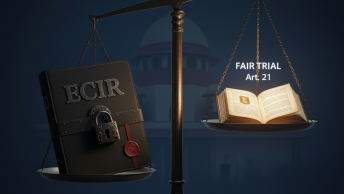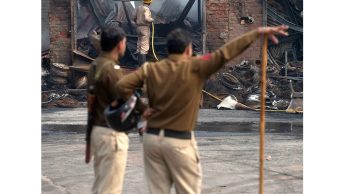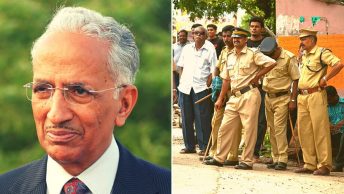(Prof. Santana Khanikar‘s review is the third post in our blog’s round-table book discussion on Jinee Lokaneeta’s The Truth Machines: Policing, Violence, and Scientific Interrogations in India moderated by Prof. Rohit De. The introductory post and the links for the other responses can be found here)
Jinee Lokaneeta’s The Truth Machines is an extremely articulate insight into the almost mythical world of machines that claim to glean truth out of human bodies. Lokaneeta’s focus on the truth machines offers a new understanding of the nature of the liberal-democratic state, especially in its postcolonial avatar, and its relationship with violence, leading to her core argument about state and police power as ‘contingent’ in nature. A theory of the ‘contingent state’, departing both from a theorisation of state power and violence within a Weberian rational-bureaucratic model, and an Agambenian state of exception model, shows us the ways in which the state, as represented by its various agents, incorporates, excludes and modifies various practices of violence based on everyday contingencies. This process takes place at a more structural level than the discretionary use of power at a micro level by individual police officers.
This contingent state, for Lokaneeta, is also disaggregated in the sense that its contingencies could be located at multiple sites such as law, science or the police. So while the argued rationale for use of truth machines could be to solve cases without using third degree physical torture, these methods were also seen as being employed to buy time, or as pushed by market forces.
Lokaneeta discusses the problematic production of a set of three techniques – namely, lie detectors, brain mapping, and narco analysis – which she imaginatively calls the ‘truth machines’, as scientific techniques. By engaging with the debates around them in the scientific community, in the judiciary both in India and in the US, and in media, she shows that these machines have attained the stature of being ‘scientific’ more through a cultural production then through rigorous review within the scientific community. Another problematic claim about these tests is that they are a step away from torture, whereas the very fact that they glean information from a body against its conscious will qualifies as torture, apart from medical concerns related to injecting of drug in the case of narco analysis. In this backdrop, Lokaneeta conceptualises the self-proclaimed role of the clinical psychologists engaged in finding ‘truth’ by using machines, as cyborgs, as almost extensions to the machines used, sometimes emphasising the mechanical side and at others their humane or psychotherapeutic side, in attempts to legitimise their position within the state forensic infrastructure and vis-a-vis the police.
Jinee argues that this shift of preference to the so-called scientific methods in place of third degree physical torture, indicates a pastoral role of the police. But this pastoral role is not something that emerges out of a respect for human rights but for more pragmatic reasons of avoiding custodial deaths. While talking about this pastoral role, however, the author indicates the presence of a pattern amidst all contingency, the pattern of only calculated torture, where there is no scope of irrationality or whims. The talk of the intent of the policemen to ‘protect’ the person in custody from too-much damage gives out the sense of almost a faith in the policeman’s rationality. Even a quote in the book from Abdul Wahid Shaikh’s memoir implies towards this: “But you should remember that the police will not kill you with the torture” (quoted in p.162). In this discourse, of calculating policemen and their preference for ‘truth machines’, there is no scope for torturing without apparent need of information. While with the theorisation of scaffolding Jinee resolves the dilemma of excess use of violence when there is an apparently posed ‘criminality’ and hence need of information, this logic appears to sit uncomfortably with instances when the police does not even accuse the killed person of any offence (a recent example could be the case of Phanidhar Bora in Nagaon, Assam).
Going back to the issue of a shift towards truth machines with attached notions of pastoral care, Jinee argues that this shift is also specifically postcolonial: in its attempt to replace torture which is seen as colonial and thereby present itself as a modern liberal democracy, in its ‘framing of modernization and science’ (p.135) and at the same time accommodating colonial legal framework of extraordinary laws, and in the coexistence of physical, mental, and other forms of violence in excess in all spheres. Apparently this may look like a shift in state power towards art of governmentality, but Lokaneeta agues that it is only a flawed attempt at the art of government. The conditions necessary for a shift in the state power, namely, addressing the question of scientific validity of the tests, have not been met, and at the same time, the focus has remained on discovering ‘truths’ or confession of some sort. The conditions enabling torture, hence, were not removed even when there was an apparent attempt to move away from physical torture. In such a scenario, truth machines are used side-by-side with more physical third degree forms of torture.
In this context Lokaneeta theorises rule of law in postcolonial India to be acting as a scaffold – a scaffold that masks the violence that goes on behind the appearance. The scaffolding here is constituted of legal technicalities, procedures, paperwork etc. produced by everyday agents of the state like the magistrate, or the doctor or the policemen. This requires that signatures or thumb impressions are taken in endless papers, that all the steps required by law to ensure safe custody, such as appearance before magistrate within a specified time, or physical examination by doctors etc, are fulfilled to perfection in paperwork though not in spirit. All these detailed following of procedure produces an effect of rule of law, an appearance.
This theorisation of scaffolding reminds me of my own observations in police stations, of how daily diary (DD) entries are maintained in a sanitised manner, by adjusting the sequence of false entry and exit timings to the phone calls that come in, through use of a rough register which is not an official record. While I commented on how these adjustments and thus keeping the DD technically perfect allowed illegalities such as pre-arrest detentions, long hours of custody and torture possible, the theorisation of scaffolding allows one to see such phenomena in a larger framework of their relation to the notions of rule of law.
Jinee argues that theorising based on the experiences of those who suffer violence – or more precisely an experiential understanding of rule of law – allows a revelation of the scaffolding and the violence that it obscures. And once revealed, this violence can be resisted. This is probably one of my biggest takeaways from the book, and is also a great comment on why field-based or bottom up narratives are so crucial for social science research.
I found the idea of scaffolding particularly interesting, and drawing on examples from areas where extra-ordinary laws (EoLs) like AFSPA are in operation, I wonder if the operation of scaffolding is even more pervasive than what Lokaneeta explicitly suggests. What I have in mind here are fake encounters, secret killings by ‘unidentified’ gunmen etc in areas under EoLs . I wonder if Lokaneeta would see the requirements and processes that lead to certain killings to be posed as ‘encounters’, or to be caused by ‘unidentified’ persons in official documentation, as attempts at scaffolding too. And if yes, then does that mean that even when the spirit of rule of law is violated by legal acceptance of EoLs, a need for some sort of a scaffolding is still exhibited by postcolonial states?







